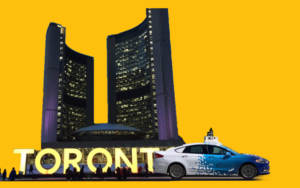The city’s plan — the result of extensive stakeholder collaboration — will embed autonomous vehicles in Toronto’s transportation planning strategy

The city’s plan — the result of extensive stakeholder collaboration — will embed autonomous vehicles in Toronto’s transportation planning strategy
The city of Toronto is moving forth with a groundbreaking preparation plan for AVs, following approval from Toronto City Council on Oct. 29.
The plan — the Automated Vehicles Tactical Plan and its accompanying three-year readiness schedule — puts the city on a timeline to be AV-ready by 2022. It outlines tests and other research identified as essential to providing the city with the knowledge it needs in order to successfully implement AVs and AV infrastructure.
As reported previously by Electric Autonomy Canada, these steps include a September 2020 shuttle trial near the Rouge Hill GO station (commuter transit) that will look at first-mile/last-mile issues, creation of a transportation innovation zone, response and incident preparation tests, human interaction tests and researching other projects such as automated sidewalk snow removal and AVs’ impact on land-use planning.
Help to achieve city goals
“Highly autonomous vehicles will bring rapid change to how we move people and things, and even deliver city services in the future,” says councillor James Pasternak, chair of the city’s Infrastructure and Environment Committee. “There is tremendous potential for this technology in helping us to achieve our broader city goals as they relate to efficiency and resiliency in our transportation network, and how they contribute to social equity, and environmental and economic sustainability.”
John Tory, mayor of Toronto, calls the plan “the first of its kind” by a North American city.
“I’m confident that the comprehensive plan adopted [Oct. 29] … will ensure we are ready to embrace the benefits of this emerging technology while preparing to confront the challenges that such an innovation will bring,” says Tory.
Extensive collaboration
The AV Tactical Plan is the product of extensive stakeholder collaboration. In total, more than more than 30 city divisions and agencies were consulted, along with more than 350 community groups and companies involved in AV development. The city also garnered input from Canadian and American academic institutions and other national and international organizations and experts.
Judy Farvolden, executive director of the University of Toronto Transportation Research Institute, applauds the plan’s scope and the city’s approach in its development.
“I think this report will be reference material for cities elsewhere to see what they should be doing,” Farvolden says. “It’s a statement of what’s understood today and what remains to be understood and the plan for incorporating these services into cities so they can achieve these goals.”
Balancing opportunities and risks
As Pasternak notes, the plan goes beyond basic AV readiness and also considers AV integration into the city’s future transportation system.
“The plan balances the long-term opportunities automated vehicles offer, such as improvements in how freight, goods and people are moved throughout the city, and how services are delivered, while anticipating and mitigating the possible risks,” according to a city news release.
“It sets the foundation for a future transportation system that improves mobility, social equity and health; considers environmental and economic sustainability; reinforces protection of privacy as well as a more integrated transportation network; aims to use automated vehicles to increase efficiency; and supports progress toward achieving safer roads.”
Ryan Lanyon, the city’s manager of transportation and innovation and chair of its AV Working Group, says this level of integration with long-term city transportation planning was the goal from the outset.
“Our city council, our community has always determined how it wants Toronto to grow in the future and the kind of city it wants to become,” says Lanyon. “The gap [we want to address] is how we achieve those goals and become the community we want to be, rather than allow the technology to shift us away from those goals.”






